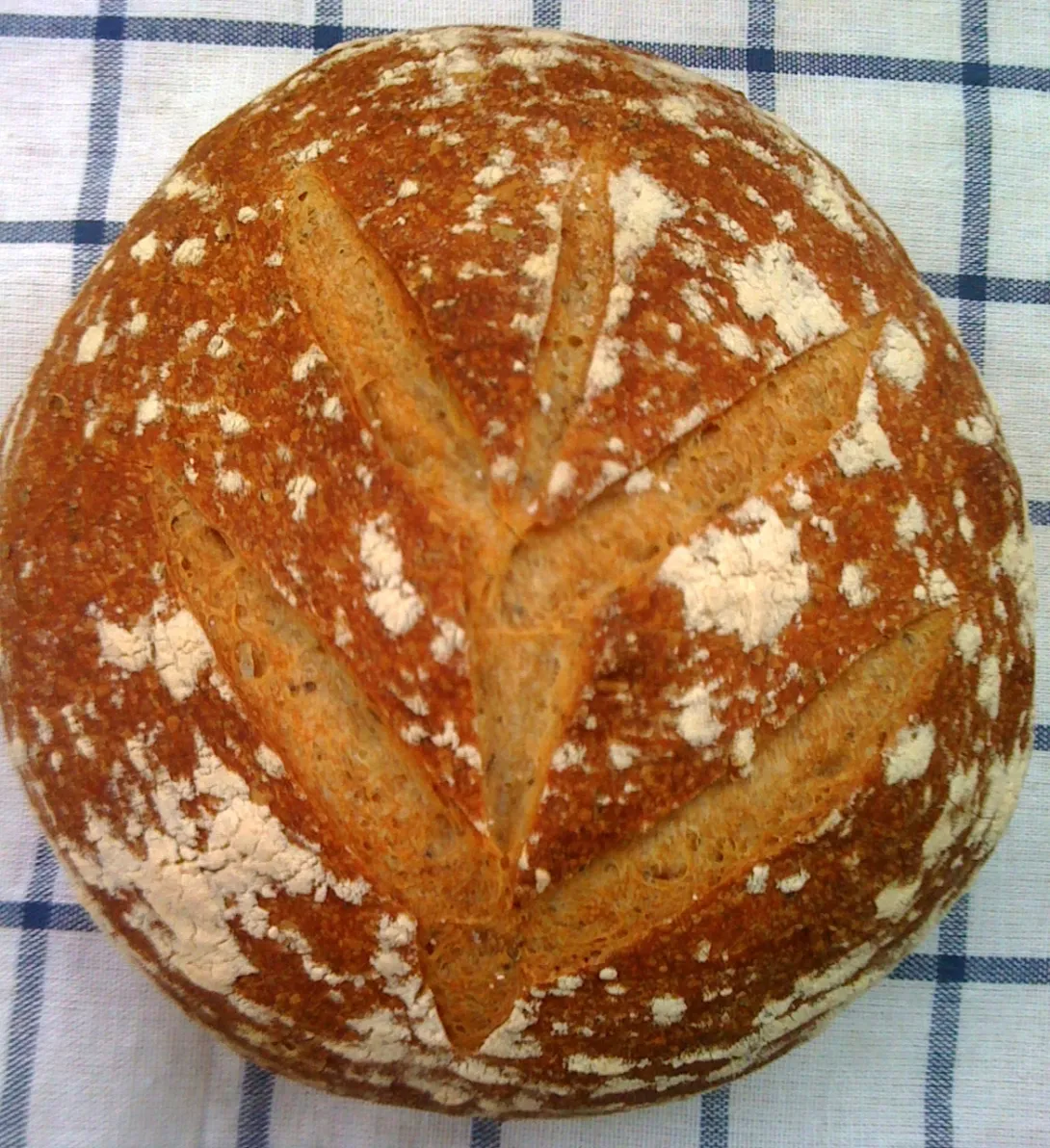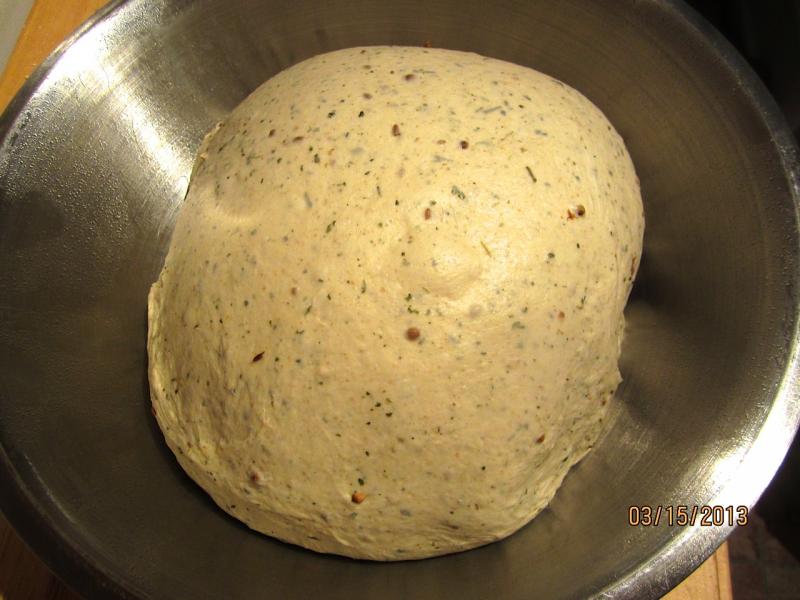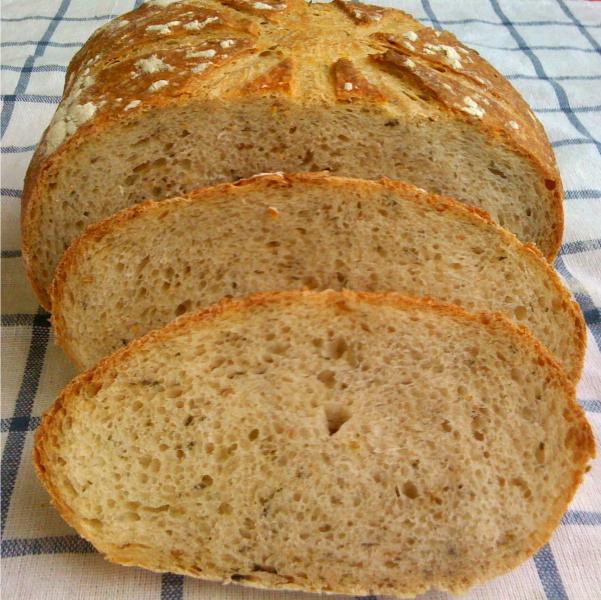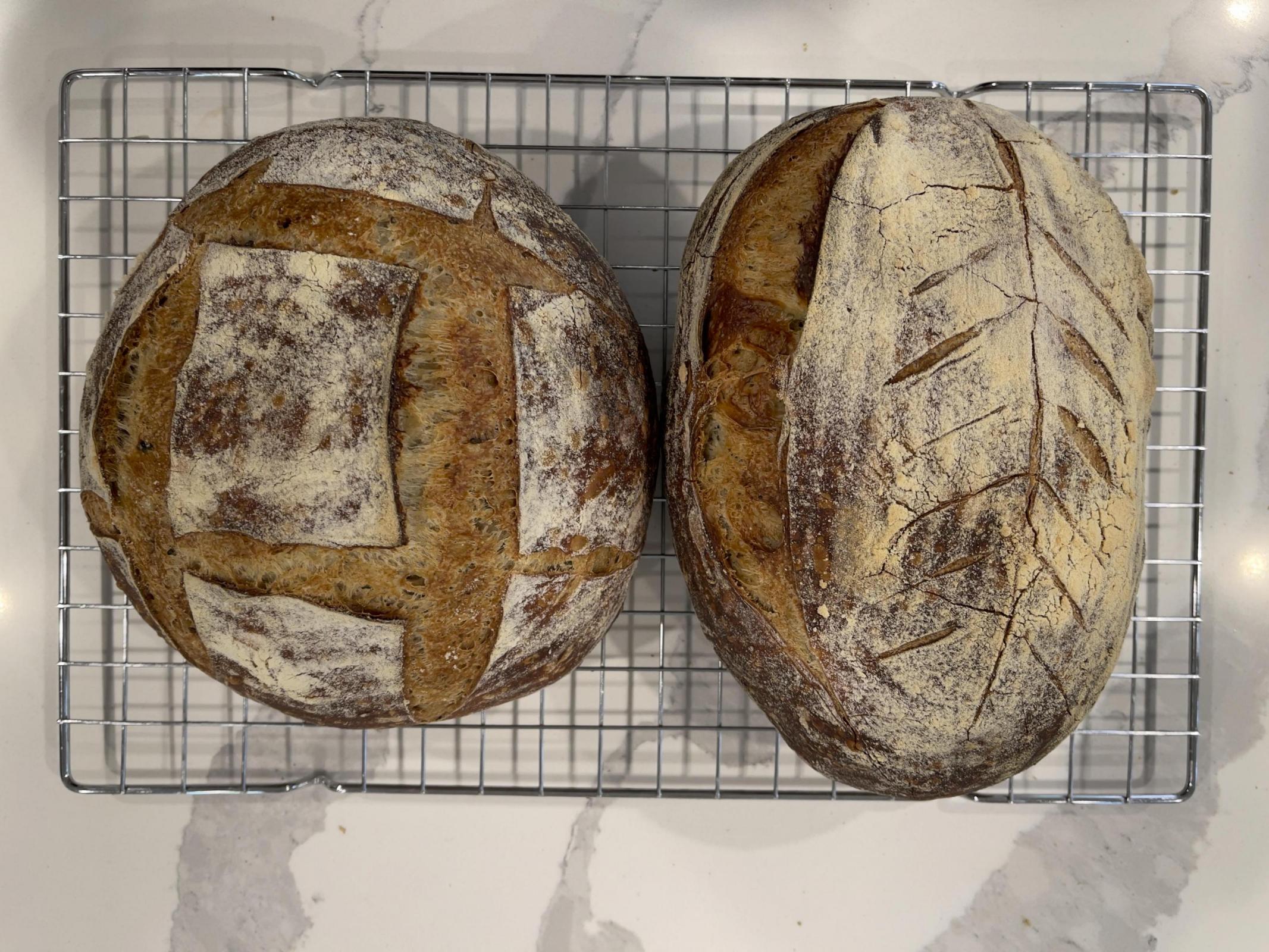
When Andy/ananda posted his student Faye's success at the "Young Baker of the Year" competition, he mentioned that Faye was inspired by my trials to re-create the taste of blue fenugreek (not available in the US) with nettle. In German that kind of flattery is called: "he brushed my tummy". I felt very much "tummy brushed" and admired the creativity of the young winner from Newcastle College. (By the way, Andy, how was the final competition in November?)
This week I looked at the recipe again, worked out how to make the 60% hydration white levain with my 75% whole wheat mother starter (Andy's recipes do not allow for Dummies), and adjusted the recipe to best fit my schedule. Nettles thrive - and burn - in abundance in Germany and Scotland, but don't grow in Maine (maybe one should introduce some to annoy pesky neighbors). So, instead of picking and home drying fresh ones, I used dried nettles from A & B Naturals, the friendly store that sell my breads. I also stretched and folded the dough (as in P. R.'s "Artisan Bread Every Day") and retarded the portioned dough overnight - something Faye most likely couldn't do under competition circumstances, anyway.
While I was preparing the dough, the house was filled with the appetizing smells of steeped nettle and toasted cumin. And the dough looked very promising. It was very smooth and elastic (I had added more water than in the original recipe), and handled very well.

Nettle Bread dough after final S & F
The next morning the dough portions had doubled in size and looked like well stuffed, bouncy pillows. The rising time of the shaped boules at room temperature was, of course, much longer than in a commercial proofer. Before the breads were fully proofed in the bannetons I noticed that their seams (on top) started opening far too wide, so I took them out and placed them, seam side down, on a parchment lined baking sheet. I didn't want gaping holes on the bottom of the loaves.
The total baking time was 35 minutes, then another 10 minutes in the switched off oven with the door slightly ajar.
This is the result:

Speckled crumb from the nettles
Faye really deserved her award - THIS BREAD IS A WINNER! It tastes quite unusual, but very delicious. We served it to out dinner guests yesterday night, and they were absolutely delighted. I think I'm going to bake this for my customers, too.
WHITE STARTER
76 g whole wheat mother starter, 75% hydration
232 g bread flour
146 g water
FINAL DOUGH
all g starter, 454 g
550 g bread flour
16 g salt
4 g instant yeast
385 g water, more as needed
3 g cumin seed, toasted
4 g coriander, ground
4 g nettle, dried
DAY 1
In the morning, prepare white starter.
In the evening, boil 200 g of the water with dried nettles, and allow to cool. Mix with rest of the water (185 g).
Mix all ingredients for final dough on low speed for 1 - 2 minute. Let dough rest for 5 minutes. Switch to medium-low speed and knead for 2 min., adjusting with more water as needed, dough should be sticky. Knead for 4 more minutes (dough should be still somewhat sticky).
Transfer dough to lightly oiled work surface. With wet or oiled hands, stretch and fold dough, gather dough into a ball, place into slightly oiled bowl, and let rest for 10 minutes. Repeat S & F another 3 x, at 10 minute intervals, misting the stretched dough before folding with more water, as needed, to keep it slightly sticky.
After the last S & F, divide dough into 2 equal portions (ca. 700 g), place in lightly oiled containers, and refrigerate overnight.
DAY 2
Remove dough from refrigerator 2 hours before using (or shape cold and let proof longer).
Shape dough into tight boules, and place, seam-side down, on parchment lined baking sheet. Sprinkle with a little flour. Cover, and let rise for 60 - 90 minutes, or until almost doubled in size (finger poke test!).
Preheat oven to 450 F/230 C, including steam pan.
Score breads. Bake them for 20 minutes (with steam), rotate pan with loaves 180 degrees, remove steam pan, and continue baking for another 25 minutes - if the sides brown faster, check after 10 minutes and turn the loaves a bit around (internal temperature 205 - 210 F/96 - 99 C).
Let breads cool on wire rack.
Post updated (some ingredient amounts and baking procedure) 6/13/16
- hanseata's Blog
- Log in or register to post comments
That's such an interesting looking dough. Can you elaborate on its "unusual" flavor?
The crumb structure looks fabulous, btw.
Hope you're able to get your breads to market in this weather!
Larry
Hi Karin,
Many thanks for posting on this and for the support and praise you offer to Faye.
Very briefly, the Competition had to be put on hold because of the bad weather we had back in late November.
It has now been re-scheduled for February 18th. I will report back, obviously.
Faye has, fortunately, managed to preserve just enough dried nettles for her to make a few more loaves to present in Bolton in a fortnight's time.
So, I'm hoping she can turn out some really special loaves in College for us to take to the competition; that's on the Thursday, day before and my 46th Birthday! I'm hoping that's a good omen!?
Again, thanks so much for posting on this
Best wishes
Andy
I'm glad to hear that, Andy, I'm sure it is a good omen - I had that recipe all the time in the back of my mind, and being stuck at home with all that snow I wanted to try something new and unusual.
I cross all my fingers for Faye! And a successful student is definitely a nice birthday present, too.
Larry, you taste the toasted cumin, and the nettle adds another flavor - actually this combination tastes probably more like blue fenugreek than the nettle-curry combination I tried last year.
We ate the bread with ham, salami, even with orange marmalade and German spicy prune jam (Pflaumenmus), and it tasted good with everyone of those. And then we served it with a Mexican casserole to our dinner guests.
I like fresh bread just with butter, too, and Irish butter (Kerrygold) is the best tasting butter we can get here in Maine.
Yes, and we keep shoveling...and shoveling...and shoveling...
Karin
Hello, Karin
It looks great, Karin! Nice crumb and scoring!!
I never used nettle in food that I thoght it was kind of medicine. Then When I looked up" Nettle" that was different from Japanese nettle and here. What kind of flavor is the nettle? I am curious. :)
Best wishes,
Akiko
Thanks, Akiko!
The nettle Urtica, also known as stinging or burning nettle, is growing nearly everywhere in the world, except for the tropics and some islands like the Baleares and Crete. I googled it - apparently it can be also found in Japan. There is another plant, though, native of Honshu, the Japanese False Nettle Boehmeria niponivea, cultivated as ornamental garden plant.
The burning nettle Urtica has a lot of properties, the fresh leaves can be used in salads, soups, quiches etc., the dried herb as tea. It tastes a little bit sour, like spinach, and my mother made nettle "spinach" for my older sister, when there wasn't enough food after the war (and nettles grew all over the ruins).
Nettle is used in Ayurvedic medicine, and part of many herbal teas. When I breast fed my children, I drank lots of tea to promote milk production (nettle, fennel, anise, caraway), and nettle is also part of cleansing teas.
And in my garden in Germany I sprayed my roses with nettle tea as preventive measure against bugs, and used fermented nettle water as fertilizer.
Karin
My, Karin! Thank you so much for researching " nettle" that a lot of information that I didn't know. I appreciate your work, Thank you Karin. I will try to use nettle!! Using nettle water as fertilizer sounds great! I also breast fed my children. I should have know about it before. :)
Best wishes,
Akiko
and very attractive even before baking. Is that all nettles? The coriander and the cumin are also there but I see reds and yellows with the green.
Mini
Thanks, Mini,
I used whole cumin and coriander seeds, and ground them with mortar and pestel (after I toasted the cumin). Therefore the dough looks so sprinkled, the seeds are more coarsely ground than if you use powdered store bought spices. The taste is, of course, stronger this way, too.
Karin
So glad to see your bread- beautiful. We've loads of nettles on my farm so will gather them for next fall's baking. I just love learning about an approach that transforms a weed into a crop. Thanks, again.
Sylviambt
Yes, I like that idea too!
Thanks for your compliment, Sylviambt
Karin
Here's a link http://www.alive.com/868a3a2.php?subject_bread_cramb=815
Cooking and drying kills the sting. One of the first plants up in the Spring.
Vinegar in salad dressings neutralize the burning abilities, too.
Karin
The "house remedy" for being stung by nettles is to rub the affected skin with a leaf from the common plantain weed. It's usually growing nearby which makes it so practical. It's the other nasty weed that likes to grow in grass (blocking out the sun) with large flat round leaves and sends up one naked looking blossom that looks more like a tail. There are two varieties, one with a broad leaf the other with long narrow pointy leaves. Both work.
Well, I've got my nettle tea leaves and ready to go.
Karin, what do you think of nigella or schwartzkümmel instead of cummin? I've been chomping on a mixture of seeds here (experimenting) and still have some left from Stan's recipe testing and they taste more to me like oregano than anything else. Potent little seeds.
Mini
in greens mom gathered, sometimes it was simply nettles, but first thing, it was a mix of nettles, dandelions, and pigweed and lightly steamed and doused with lemon juice and butter or if no lemons vinegar and butter. Nettles are a tonic like dandelions, a bitters as they are called,which are good for your liver.
Never have cooked anything other than greens, but will definitley try the bread, since nettles are wild here.
I am terribly allergic to the sting, so have to be very careful of them, I was stung when I was around 5, over around 50% of my skin, I was a very sorry camper for a week, and now I blister violently when stung by them. An antidote to the sting, is believe it or not, the leaf end of a rhubarb stalk rubbed on the blister. I found that out, when getting stung picking a stalk of rhubarb to eat about 5 years after, the best rhubarb was garded by stinging nettles.
Yes, I came into too close contact to stinging nettles often enough, but I didn't eradicate them in my garden in Germany because of their many benefits, and, also because they are sole food plant for the caterpillar of a very pretty butterfly.
Fortunately I'm not allergic to the burn, though I had once a nettle soup where somebody who didn't know what he was doing, garnished the soup with a little bit of fresh chopped nettle. What a nasty surprise when I swallowed a spoonful!
Interesting, what you experienced with the rhubarb juice, Eva. I found that the homoeopathic drug Apis D6 (bee poison) helps against the rash caused by nettles, too.
Happy baking,
Karin
and ant bites all have formic acid in them, which is the nettle component that is the stinging part. I'm also allergic to bees, and am extremely careful with ants especially the red variety. But the rhubarb leaf end rubbed on the bee sting works too! So that is always good to know.
I cannot imagine putting fresh nettles on soup for a garnish, which means the person who did that, didn't understand that its the drying or cooking that removes the sting.
I was just looking at my Richter's herb catalogue and they have stinging nettle seed, if you wanted to grow some, they do US shipments.
www.richters.com I think is their web site, they also supply dried nettle and many other herbs of various sorts, and seeds and plants of a great many different herbs. They have a huge selection of thyme seeds, and oreganos and rosemarys, I am going to put an order together and see if I can't grow some herbs this summer.
I use a lot of parsley and oregano in my cooking, and lately have tried some rosemary, which I grew last summer in a pot in the yard.
Eva, my neighbors might lynch me, if I introduce nettles in our garden. I like to use homoeopathic and herbal remedies, though, and I love cooking with herbs. I "inherited" a large (difficult to haul) potted rosemary, that I keep indoors in winter (obstructing my stairwell) and outdoors in summer. I use the rosemary regularly for Potato Rosemary Bread (from WBG), you need quite a bit, so it's nice to have a plant at home.
Mini, I have never used Nigella in recipes, yet, only know the pretty blue flower Nigella. I would give it a try, why shouldn't another spicy herb work as well? I know which plant you mean with plantain, in German it's called Wegerich. I didn't know it helped against nettle burns.
Thanks for sharing your informations,
Karin
So have to start again, with a new plant this spring. I like having the dried ones to put in stews though, as its tasty! Haven't tried it in bread yet, but hey I haven't had a moment to actually make bread for too long.
Plantian is also supposed to be useable for wounds, you wrap the wound in the leaves, and then in gauze and its supposed to draw out poison and heal the wound.
It grows profusely in the yard here, but not a single nettle! How odd, and yet they did grow close in the yard where the rhubarb plant was. So wonder why no nettles in my yard. Maybe they know they'd get eaten.
Hmm. couldn't just tell the neighbours that the nettles were something else?? I suppose they might know, but then again, if you gave them a loaf of fresh nettle bread they might not complain too much! LOL
Karin, I saw this post yesterday, and I can't get it of my mind. I want to bake this bread and I think I can get fresh nettles. How much should I use? Should I boil them before, or not? Any advise would be appreciated. I never thought of using nettles in my breads, I'm very curious about the taste they give.
Your breads are so inspiring, so good looking! It's always a pleasure to read your posts.
codruta
Codruta, in the original recipe, Faye obviously used fresh nettles, and dried them in the oven. See Andy's (ananda's) blog http://www.thefreshloaf.com/node/20318/young-baker-competition-half-term-home-baking
For the bread she took then 4 g of the dried nettles and boiled them in water.
I also used nettles (plus curry) as a substitute for blue fenugreek in my Tyrolean rolls "Vinschger Paarlen":
http://www.thefreshloaf.com/keyword/brotklee
They have a distinct flavor, you should try the bread.
Karin
Karin, thank you for the links. I already picked up fresh nettles (I hope the autumn nettles are good too, cause I know peoples usually eat them in the spring, when are very fresh). I'll post about it when I'll make the bread.
Best wishes, Codruta
I baked a nettle loaf with rye starter and decided to skip the cumin & coriander as the main dish has plenty of it and is pretty spicy chili wise. So this is loaf is more like a Neat Nury Nettle loaf. I can't really say what the nettles taste like but the bread is good! I did spread a little salmon pate on some... delicious!
Mini - the nettles alone have a more subtle flavor. I made once a nettle tarte and had a nettle soup in a restaurant - it tastes like a kind of spicier spinach.
Karin
Question: How long is the recommended bench proofing?
The instructions say "Remove dough from refrigerator 2 hours before using (or shape cold and let proof longer)." And later it says "Cover, and let rise for 60 - 90 minutes, or until almost doubled in size (finger poke test!)." So, roughly the total time bench proofing is the 2 hours before using and then the 60-90 minutes for a total of 3 to 3.5 hours? Or does the word 'using' imply that it goes into the oven after the 2 hr bench rest?
You are right - it’s 2 hours de-chilling time for the dough plus the additional 60 - 90 minutes proofing time (or what is needed) for the shaped loaf.
Though you can shape the dough directly from the fridge, I would usually only do that with small pieces like rolls or baguettes, since they warm up much quicker.
Good luck!
So, I'm making the bread and will bake tomorrow so the die is cast, but it seems odd to me to do the shaping after refrigeration. All the SD techniques I've used have specified that one shapes the bread and put in the banneton before it goes into the fridge. Then in the morning it goes into the oven after scoring. It seems like you would lose all the advantages of the dough filling with CO2 bubbles overnight if you did the shaping in the morning and only let it rest the 60-90 minutes. That being said, the photos of the bread in the recipe look great so the alternative technique clearly works. It just seems to run against much of what I've learned. But, that's why we are all here, which is to learn.
Turned out pretty good although I'm a fan of more aerated crumbs. I did the shaping before putting in the refrigerator so only had to let sit before scoring. Baked both in a Dutch Oven covered for 20 minutes and then uncovered 20 minutes approximately. I would describe the bread as a rustic bread and a good representation of that genre. The flavor was very earthy, organic and herbaceous. It's not my personal favorite of the Sourdough breads, but if I wanted to demonstrate a rustic bread or a bread that was grown from herbs in my backyard, this is an excellent example.
This bread was invented before Chad Robinson came up with his hole-y breads, but nowadays my to-go loaves are, also, of the airier kind.
Funny, in earlier times these crumb structures would have been considered serious flaws. I don’t mind strong flavors, though, and always like to try out something new.